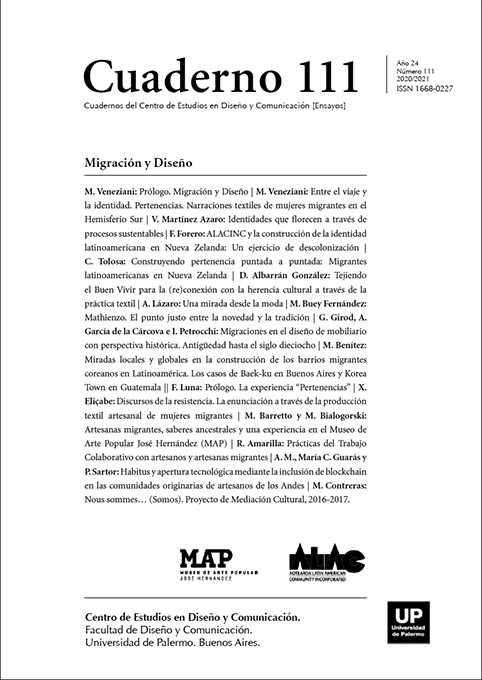Construyendo pertenencia puntada a puntada: Migrantes latinoamericanas en Nueva Zelanda
Resumen
Ubicado en el contexto global de la migración humana contemporánea y los altos grados de movilidad, este proyecto multimodal examinó cómo las narrativas y la creación de textiles permitieron a un grupo de mujeres migrantes latinoamericanas a Nueva Zelanda re-presentar y re-construir su sentido de pertenencia y su identidad. En Nueva Zelanda, la comunidad de migrantes de América Latina es relativamente pequeña (menos del 1% de la población con un poco más de 13,000 personas en el censo de 2013) pero diversa, ya que incluye migrantes que han llegado al país en oleadas separadas desde la década de 1970. Como tal, es un grupo heterogéneo con personas de diferentes países que han migrado a Nueva Zelanda por diferentes razones y con diferentes habilidades y aspiraciones. Sus historias de migración han sido escasamente documentadas; en particular, poco se sabe acerca de las experiencias de las mujeres migrantes latinoamericanas.
Citas
Akbari, S. A. H., & Macdonald, M. (2014). Immigration policy in Australia, Canada, New Zealand and the United States: An overview of recent trends. International Migration Review, 48(3), 801-822. doi:10.1111/imre.12128
Barkhuizen, G. (2013). Maintenance, identity and social inclusion narratives of an Afrikaans speaker living in New Zealand. International Journal of the Sociology of Language, 2013(222), 77-100.
Blommaert, J. (2010). The sociolinguistics of globalization. Cambridge, England: Cambridge University Press.
Blommaert, J. (2013). Superdiversity, ethnography and linguistic landscapes: Chronicles of complexity. Bristol, England: Multilingual Matters.
Buitelaar, M. (2014). ‘Discovering a different me’: Discursive positioning in life story telling over time. Women’s Studies International Forum, 43, 30-37. doi:10.1016/j.wsif.2013.07.017
Canagarajah, S. (2013). Agency and power in intercultural communication: Negotiating English in translocal spaces. Language and Intercultural Communication, 13(2), 202-224. doi:10.1080/14708477.2013.770867
Colic-Peisker, V. & Tilbury, F. (2007). Integration into the Australian labour market: The experience of three ‘visibly different’ groups of recently arrived refugees. International Migration, 45(1), 59-85. doi:10.1111/j.1468-435.2007.00396.x
Dürr, E. (2011). To belong in Aotearoa New Zealand: Latin American migrant experiences in multicultural Auckland. Journal of Ethnic and Migration Studies, 37(3), 503-519. doi:10.1080/1369183X.2011.521359
Garlock, L. R. (2016). Stories in the cloth: Art therapy and narrative textiles. Art Therapy, 33(2), 58-66. doi:10.1080/07421656.2016.1164004
Griffiths, S. (2008). The experience of creative activity as a treatment medium. Journal of Mental Health, 17(1), 49-63. doi:10.1080/09638230701506242
Johnson, J. S. & Wilson, J. E. (2005). “It says you really care”: Motivational factors of contemporary female handcrafters. Clothing and Textiles Research Journal, 23(2), 115-130. doi:10.1177/0887302×0502300205
Moxley, D. & Feen-Calligan, H. (2015). Arts-inspired design in the development of helping interventions in social work: Implications for the integration of research and practice. British Journal of Social Work, 46(6), 1-18. doi:10.1093/bjsw/bcv087
Musgrave, S. & Bradshaw, J. (2014). Language and social inclusion: Unexplored aspects of intercultural communication. Australian Review of Applied Linguistics, 37(3), 198-212.
Norton, B. (2010). Identity, literacy, and English-language teaching. TESL Canada Journal, 28(1), 1-13.
Norton, B. & Toohey, K. (2011). Identity, language learning, and social change. Language Teaching 44(4), 412-446 doi:10.1017/S0261444811000309
Pavlenko, A. (2001). Language learning memoirs as gendered genre. Applied Linguistics, 22, 213-240. doi:10.1093/applin/22.2.213
Pavlenko, A. (2007). Autobiographic narratives as data in applied linguistics. Applied Linguistics, 28(2), 163-188. doi:10.1093/applin/amm008
Pennycook, A. D. (2007). Global Englishes and transcultural flows. London, England: Routledge.
Piller, I. & Pavlenko, A. (2009). Globalization, multilingualism, and gender. In V. Cook & L. Wei (Eds.), Contemporary Applied Linguistics. Volume 2. Linguistics for the real world (pp. 10-27). London, England: Continuum.
Rassool, N. (2012). English and migration. In A. Hewings & C. Tagg (Eds.), The politics of English: Conflicts, competition, co-existence (pp. 47-92). Abingdon, England: Routledge.
Rawdon, K. & Moxley, D. (2016). Connecting social work and activism in the arts through continuing professional education. Journal of Teaching in Social Work, 36, 431-443. doi: 10.1080/08841233.2016.1207747
Riessman, C. K. (2008). Narrative methods for the human sciences. Thousand Oaks, CA: Sage.
Ricento, T. (2005). Considerations of identity in L2 learning. In E. Hinkel (Ed.), Handbook of research on second language teaching and learning (pp. 895-911). Mahwah, NJ: Lawrence Erlbaum.
Riley, J. (2008).Weaving an enhanced sense of self and a collective sense of self through creative textile-making. Journal of Occupational Sciences, 15(2), 63-73.
Rushdie, S. (1992). Imaginary homelands. New York, NY: Penguin Books.
Spoonley, P. & Bedford, R. (2012). Welcome to our world? Immigration and the reshaping of New Zealand. Auckland, New Zealand: Dunmore Publishing.
Sonn, C. C. (2002). Immigrant adaptation: Understanding the process through sense of community. In A. T. Fisher, C. C. Sonn, & B. J. Bishop (Eds.), Psychological sense of community: Research, applications, and implications (pp. 205-222). New York, NY: Kluwer Academic.
Statistics New Zealand. (2013). 2013 Census ethnic group profiles: Latin American Retrieved from http://www.stats.govt.nz/Census/2013-census/profile-and-summary
Thoits, P. A. (1986). Social support as coping assistance. Journal of Consulting and Clinical Psychology, 54, 416-423.
Los autores/as que publiquen en esta revista ceden los derechos de autor y de publicación a "Cuadernos del Centro de Estudios de Diseño y Comunicación", Aceptando el registro de su trabajo bajo una licencia de atribución de Creative Commons, que permite a terceros utilizar lo publicado siempre que de el crédito pertinente a los autores y a esta revista.


